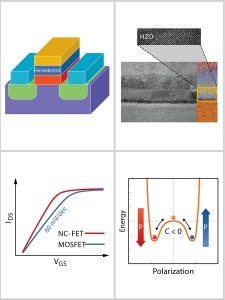Mar 14 2019
Smartphones consist of a large number of small switches known as transistors that could help manage multiple tasks more than making calls—navigating neighborhoods, sending texts, Googling names, and snapping selfies.
 Schematic image of a NC-FET where a CMOS-compatible ferroelectric HZO layer is part of the gate stack to realize negative capacitance in the gate stack and sub-60 mV/dec transistor operation. (Image credit: Peide D. Ye)
Schematic image of a NC-FET where a CMOS-compatible ferroelectric HZO layer is part of the gate stack to realize negative capacitance in the gate stack and sub-60 mV/dec transistor operation. (Image credit: Peide D. Ye)
These transistors use an electrically conducting channel whose conductivity can be altered using a gate terminal, which is separated from the channel by a 5- to 6-atom-thick dielectric film.
For the past five decades, transistors have been made smaller on the basis of Moore’s law, a finding that the number of transistors on a chip increases two-fold about every 1.5 years, while the cost is reduced to half. However, at present, a point has been reached where transistors cannot proceed to be scaled any longer.
In a new study, published in Applied Physics Letters, from AIP Publishing, the scientists have reviewed negative capacitance field-effect transistors (NC-FETs), a new device principle proposing that conventional transistors could be manufactured more efficiently by just adding a thin layer of ferroelectric material. The same chip could compute considerably more provided it works, despite the need for less frequent charging of its battery.
The physics behind this technology is being evaluated across the world, and in their study, the scientists have outlined the advanced research with NC-FETs and the demand for coherent and self-consistent interpretation of various experiments that are being described in the published works.
NC FETs were originally proposed by my colleague professor Supriyo Datta and his graduate student Sayeef Salahuddin, who is now a professor at the University of California, Berkeley.
Muhammad Ashraful Alam, Professor of Electrical and Computer Engineering, Purdue University.
Initially, Alam found the NC-FET concept interesting—because it focuses on an urgent issue of discovering a novel electronic switch for the semiconductor industry and is being used as a conceptual framework for a wide class of phase-transition devices commonly known as “Landau switches.”
More recently, when my colleague and co-author professor Peide Ye started experimentally demonstrating these transistors, it was an opportunity to work with him to explore deeply intriguing features of this device technology. Our article summarizes our ‘theorist-experimentalist’ perspective regarding the topic.
Muhammad Ashraful Alam, Professor of Electrical and Computer Engineering, Purdue University.
Although many articles related to this topic have been published, according to the research team, the frequency-reliability restrictions of NC-FET and the validity of quasi-static NC are still being vigorously discussed.
Given that the analysis is conclusively demonstrated and linked to present-day ICs, the effect of the NC-FETs would be transformative.
Given the potential, there is a need for systematic analysis of the device concept. We found that the data from various groups has a wide scatter and researchers are using very different techniques to characterize their devices. This requires an integrated and comprehensive analysis of the existing data set.
Peide D. Ye, Purdue University.
It is hoped by the scientists that their research would bring the community together to propose ways of making a coordinated advance toward achieving this successful technology.